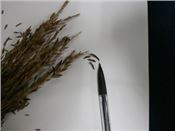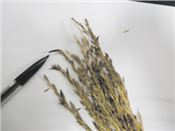Fungus Amongst Us: Ergot A Concern In Area Fescue Fields

Ergot Fungus: Ergot a Concern in Area Fescue Fields: The cool, wet spring has provided good growing conditions for a fungus that grows on some plant seedheads on fescue in the Ozarks.
Photo credit: MU Extension
MT. VERON, MO.
The cool, wet spring has provided good growing conditions for a fungus that grows on some plant seedheads. The plant that is most prevalent in the Ozarks on which the ergot fungus thrives is fescue.
Fescue plants may harbor the ergot, and it is easy to see this time of year simply by closely examining the seed heads.
“Ergot by now has replaced a developing seed and is hard and black. Some describe it as looking like mouse droppings,” said Eldon Cole, a livestock specialist with University of Missouri Extension.
A visit to a fescue seed buying station may also be a good place to see lots of ergot.
TOXIC FUNGUS
Ergot is capable of producing toxic alkaloid compounds similar to those produced by the endophyte fungus found within the cells of a fescue plant. The endophyte fungus must be viewed under a microscope to see while ergot is easily visible to the naked eye.
Both of these fungi produce toxins that when consumed by cattle, horses, sheep and goats results in elevated body temperatures and constricted blood flow.
“Cattle that eat it likely will show extreme heat stress, appear to grow hair in warm weather and have high respiration rates,” said Cole. “Another symptom can be sore, swollen rear pasterns and areas below the animal’s hocks.”
In severe situations, this causes a break in the skin above the juncture of the hoof and hair line. Ultimately, the lower portion of the leg may be lost. This occurs more often in cold weather and is usually associated with the endophyte-produced toxin in the fall. Hooves and tail switches may also be lost.
PREVENTION
Prevention of problems, particularly from ergot, is possible by removing cattle soon from the pasture when symptoms are noted. Clipping of pastures in mid-May removes the temptation for cattle that like to strip ergot-containing seedheads.
“Toxins from ergot can cause reproductive problems in cattle as well as in equine,” said Cole.
Ergot appears in fescue and grains like barley, rye, wheat, and triticale. Ryegrass and timothy may also be sources for the fungus. Novel endophyte fescue varieties may develop ergot.
“Hay harvested from ergot-infested fields will likely lose ergot bodies during harvest. However, it may never be totally toxin free. More research on that topic needs to be done,” said Cole. ∆
